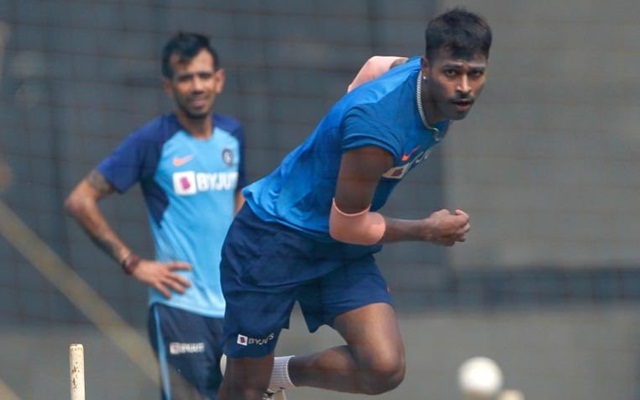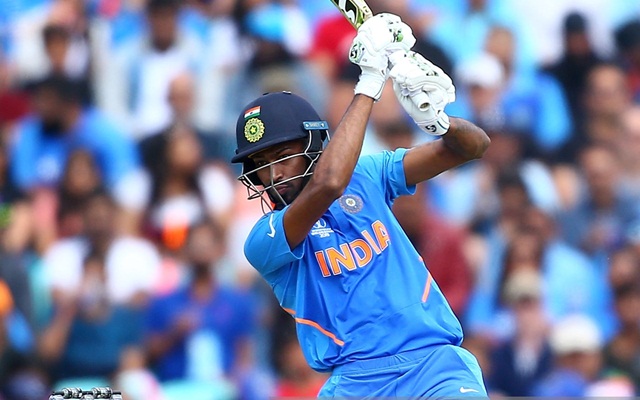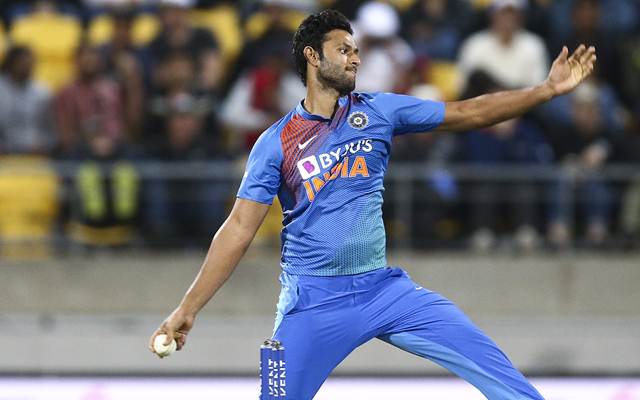Breaking down Hardik Pandya's absence from the cricketing surface
The 26-year-old aggravated the injury he had endured during the Asia Cup in 2018, which makes one question the way he was treated in the midst of a busy spell of fixtures for India.
2 Min Read


After over five months of desolating absence, Hardik Pandya was tasked with his first opportunity in the local DY Patil Tournament, which commenced on February 24 at Navi Mumbai’s DY Patil stadium. The swashbuckling all-rounder had sustained a severe lower back injury back in September while plying his trade for the Indian team in the Asia Cup.
He did not play, much to the surprise of many, as Reliance 1– the team he was registered under– went on to beat Indian Navy comprehensively by 58 runs. But things did not end there for Pandya. The swashbuckling all-rounder hogged the headlines after smoking a quick-fire century in just 37 balls. The Baroda player got out on 105 off just 39 balls. His blistering strike-rate of 269.23 was enough to catch the eye of everyone.
Pandya weaved his innings around 8 fours and 10 sixes. The 26-year-old dazzled with the ball too as he scalped fifer in the match. Amid clouds hovering over his comeback, the all-round gave a befitting reply to all his doubters. A long-awaited return to the fold was put to halt for unknown reasons, and we, therefore, try to analyse what could have been the reason for Pandya’s continued absence in this curious case.
Pandya’s injury timeline
Prior to its onset, it’s important to note that Hardik Pandya was already suffering from minor strains in his lower back. After a demanding World Cup campaign that saw India finish as semi-finalists, Pandya was supposedly overburdened with responsibilities owing to the unique breed of all-rounders he belongs to.
The 26-year-old aggravated the injury he had endured during the Asia Cup in 2018, which makes one question the way he was treated in the midst of a busy spell of fixtures for India. In October, he had to fly to London to undergo an acute lower-back surgery.
“Hardik Pandya complained of lower back pain after India’s final T20I against South Africa in Bengaluru on 22nd September. The BCCI Medical Team consulted a panel of spine specialists in England and they recommended surgery for a long-term solution of this issue. The all-rounder travelled to London on 2nd October with Team India physiotherapist Mr Yogesh Parmar. On Friday, a successful surgery was conducted. Hardik will soon commence his rehabilitation process,” announced a BCCI statement.
The operation was successful, after which he flew back to the National Cricket Academy (NCA) stationed in Bangalore. Often a buzzing figure in the outside world and social media, Pandya took little time to announce his return date.
In December 2019, he affirmed– “We thought this was the right time [for the surgery] because even if I take four months, I will be coming back before the New Zealand series, mid-way actually.”
While there seem to be no signs of Pandya in the picture as of yet, there hasn’t been a substantial update on his availability for the forthcoming South Africa series in March. He was seen knocking, jogging and taking part in brief throw-down sessions earlier last month, but his progress dented when he failed to clear the fitness Test in mid-January ahead of the ongoing New Zealand tour.
Pandya perhaps jinxed his return date to the anguish of Indian supporters who continue to wait in high levels of anticipation to watch him mark his comeback into the setup. He was called into action despite not playing a solitary Ranji Trophy match.
And now finally, we wait and see if the all-rounder can fasten his return in the DY Patil Tournament. His side Reliance 1 are scheduled to play a couple of more fixtures on February 28 and March 3.
Role of the NCA and root cause behind the delay

It’s safe to point a finger at the Indian management to have allowed him to carry on even after the World Cup. Lower back issues always form a formidable obstacle if not scanned earlier, as seen with various cases around the cricketing circuit in recent years.
The NCA has been guilty of setting rather lofty deadlines for their players to recover, often failing to match them. Cases of Kamlesh Nagarkoti and Prithvi Shaw serve as good examples of apparent substandard management, while Ishant Sharma, who dusted the injury off his shoulders completely in the first Test against New Zealand, portrayed the other side of the Bangalore-based academy.
Pandya’s setback may have been a mix of both. His failure to make it for the New Zealand tour may have come in as a blessing in disguise, offering him a longer rest period. NCA surely has a part to play in the same, having failed to prepare him for the long tour. And now, he even sat out of his side’s first game in the local tournament.
“Yes, his name is there in the team list for Reliance1. He will play in the DY Patil T20, provided the National Cricket Academy releases him,” said a source earlier, a couple of days back.
While NCA stands as a questionable figure in the equation, there’s no denying that their methodology in Hardik Pandya’s rehabilitation has been timely, orthodox and effective. Conceivably, he has been monitored closely despite repeated questions from the entire country. They’ve taken a slow approach towards the remaking of one of the best all-rounders in the world and remained unfazed and rather strict with his availability.
When could we see Pandya return to action?

Having trained orderly at the NCA, step-by-step, Pandya is most definitely not far away from full fitness. Chances of a spot in the South Africa squad, however, appear bleak, given the nature of his injury and inconsistent update on fitness.
It may well be too much to ask of him, but Mumbai Indians will be positive ahead of the IPL, which is still just over a month away. Tactically viewing the situation, the hierarchy may not want to risk him against South Africa – a team that has a slew of problems hovering over them in the last 12 months. The IPL, after the World Cup priority, should be the way to go for Pandya after he has gone through the gradual, slow-paced grind.
Looking at other options

Should the expressive all-rounder fail to make the cut for the South Africa series, India may again have to look at differentials in their middle-order – a fragment of their batting line-up that has camouflaged by just blending in with the top order stalwarts.
Starting off with Shivam Dube– the southpaw came into the T20I series against the Kiwis off the back of a fine-tuned, progressive 54 against the West Indies back in December. However, scores of 13, 8*, 3, 12, 5 make for grim reading, especially when the entire team outplayed their counterparts throughout. Not to mention, his bowling attributes haven’t come to the fore either, with Virat Kohli sparingly using him during the mid-stages of an inning.
Tamil Nadu talisman Vijay Shankar too, seems to be a reasonable option, given how he grabbed his opportunity in the warm-up matches. A well-made 66 in the second unofficial Test match illustrated his sound technique, ability to deal with the extra bounce and overall temperament. He also glimmered in the limited-overs warm-up games, albeit intermittently. But, Shankar offers more with the ball and may be presented with a chance in the Indian team once again.
The void left by Pandya in the team can also be filled by a specialist batsman with the accommodation of an extra bowler. That would beef up the batting order, but limit variety in the bowling department. Manish Pandey and Kedar Jadhav, pretty much on the fringes of the Indian squad at present, may have to rise to the occasion whenever called upon. With the youngsters in Sanju Samson and Shubman Gill vying for spots in the batting order, it’s certain that their time in international cricket, for now, lies on the brief chances they receive.
The X-Factor blooded by Pandya with the bat and ball as well as on the field is certainly something Virat Kohli and his management are missing.
Download Our App